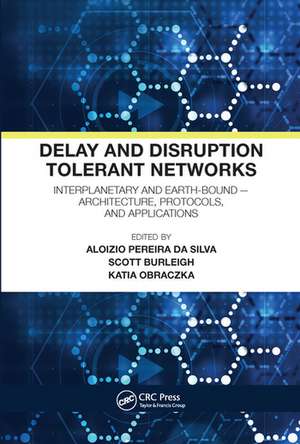Delay and Disruption Tolerant Networks: Interplanetary and Earth-Bound -- Architecture, Protocols, and Applications
Editat de Aloizio Pereira da Silva, Scott Burleigh, Katia Obraczkaen Limba Engleză Paperback – 30 iun 2020
Preț: 455.41 lei
Nou
Puncte Express: 683
Preț estimativ în valută:
87.14€ • 90.99$ • 71.96£
87.14€ • 90.99$ • 71.96£
Carte tipărită la comandă
Livrare economică 15-29 aprilie
Preluare comenzi: 021 569.72.76
Specificații
ISBN-13: 9780367571146
ISBN-10: 0367571145
Pagini: 486
Dimensiuni: 156 x 234 x 33 mm
Greutate: 0.76 kg
Ediția:1
Editura: CRC Press
Colecția CRC Press
ISBN-10: 0367571145
Pagini: 486
Dimensiuni: 156 x 234 x 33 mm
Greutate: 0.76 kg
Ediția:1
Editura: CRC Press
Colecția CRC Press
Public țintă
Academic and Professional Practice & DevelopmentCuprins
1. Introduction, Daniel Oberhaus.
2. Delay and Disruption Tolerant Network Architecture, Aloizio P. Silva, Scott Burleigh, and Katia Obraczka.
3. DTN Platforms, Aloizio P. Silva and Scott Burleigh.
4. Case Study: Interplanetary Networks, Aloizio P. Silva and Scott Burleigh
5. Delay and Disruption Tolerant Network Routing, Aloizio P. Silva, Scott Burleigh, and Katia Obraczka
6. DTN Coding, Marius Feldmann, Felix Walter, Tomaso de Cola, and Gianluigi Liva.
7. DTN for Spacecraft, Keith Scott.
8. Delay-Tolerant Security, Edward Birrane.
9. DTN of Things, Juan A. Fraire and Jorge M. Finochietto.
10. DTN Congestion Control, Aloizio P. Silva, Scott Burleigh, and Katia Obraczka.
11. Licklider Transmission Protocol (LTP), Nicholas Ansell.
12. Delay-/Disruption- Tolerant Networking Performance Evaluation with DTNperf_3, Carlo Caini.
2. Delay and Disruption Tolerant Network Architecture, Aloizio P. Silva, Scott Burleigh, and Katia Obraczka.
3. DTN Platforms, Aloizio P. Silva and Scott Burleigh.
4. Case Study: Interplanetary Networks, Aloizio P. Silva and Scott Burleigh
5. Delay and Disruption Tolerant Network Routing, Aloizio P. Silva, Scott Burleigh, and Katia Obraczka
6. DTN Coding, Marius Feldmann, Felix Walter, Tomaso de Cola, and Gianluigi Liva.
7. DTN for Spacecraft, Keith Scott.
8. Delay-Tolerant Security, Edward Birrane.
9. DTN of Things, Juan A. Fraire and Jorge M. Finochietto.
10. DTN Congestion Control, Aloizio P. Silva, Scott Burleigh, and Katia Obraczka.
11. Licklider Transmission Protocol (LTP), Nicholas Ansell.
12. Delay-/Disruption- Tolerant Networking Performance Evaluation with DTNperf_3, Carlo Caini.
Notă biografică
Aloizio P. Silva has Phd degree at Department of Computer and Eletronic Engineer Instituto Tecnológico de Aeronáutica (ITA) (2015). PMP Certified. Master of Business Administration (MBA) in Project Management at Fundação Getúlio Vargas (FGV) (2008) and Master Degree in Computer Science at Federal University of Minas Gerais (2002) and Undergraduate in Computer Science at Pontifícia Universidade Católica de Minas Gerais (1999) . Have experience in the area of Computer Engineering, specifically in Distributed Systems, Computer Networks, Algebraic Topology, Telecommunication Networks and Software Engineer, working mainly in the following subjects: space data systems, wireless space data systems, delay and disruption tolerant networks, wireless communication, location-based services, quality of service, wireless data services, Interplanetary Networks, Mobile Computing and wireless sensor networks. Currently, JPL-NASA/Caltech affiliate at interplanetary network team. Also, visitor researcher at University of California Santa Cruz at department of computer engineering.
Scott Burleigh has been developing software at JPL since 1986. He was a co-author of the specifications for the Consultative Committee for Space Data Systems (CCSDS) File Delivery Protocol (CFDP) and Asynchronous Message Service (AMS), and as a member of the Delay-Tolerant Networking (DTN) Research Group of the Internet Research Task Force. He co-authored the specifications for the DTN Bundle Protocol (RFC 5050) and the DTN Licklider Transmission Protocol for delay-tolerant ARQ (RFC5326). He has developed implementations of these protocols that are designed for deep space mission systems, aiming to enable deployment of a delay-tolerant Solar System Internet.
Katia Obraczka is Professor of Computer Engineering at UC Santa Cruz. Her research interests span the areas of computer networks, distributed systems, and Internet information systems. Her lab, the Internetwork Research Group (i-NRG) at UCSC, conducts research on designing and developing protocol architectures motivated by the internets of the future. She has been a PI and a co-PI in a number of projects sponsored by government agencies (e.g., NSF, DARPA, NASA, ARO, DoE, AFOSR) as well as industry (e.g., Cisco, Google, Nokia).
Scott Burleigh has been developing software at JPL since 1986. He was a co-author of the specifications for the Consultative Committee for Space Data Systems (CCSDS) File Delivery Protocol (CFDP) and Asynchronous Message Service (AMS), and as a member of the Delay-Tolerant Networking (DTN) Research Group of the Internet Research Task Force. He co-authored the specifications for the DTN Bundle Protocol (RFC 5050) and the DTN Licklider Transmission Protocol for delay-tolerant ARQ (RFC5326). He has developed implementations of these protocols that are designed for deep space mission systems, aiming to enable deployment of a delay-tolerant Solar System Internet.
Katia Obraczka is Professor of Computer Engineering at UC Santa Cruz. Her research interests span the areas of computer networks, distributed systems, and Internet information systems. Her lab, the Internetwork Research Group (i-NRG) at UCSC, conducts research on designing and developing protocol architectures motivated by the internets of the future. She has been a PI and a co-PI in a number of projects sponsored by government agencies (e.g., NSF, DARPA, NASA, ARO, DoE, AFOSR) as well as industry (e.g., Cisco, Google, Nokia).
Descriere
This book presents the fundamental principles that underline DTNs. It explains the state-of-the-art on DTNs, their architecture, protocols, and applications. It also explores DTN’s future technological trends and applications. Its main goal is to serve as a reference for researchers and practitioners.
